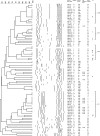Molecular epidemiology and distribution of serotypes, surface proteins, and antibiotic resistance among group B streptococci in Italy
- PMID: 17634303
- PMCID: PMC2045288
- DOI: 10.1128/JCM.00999-07
Molecular epidemiology and distribution of serotypes, surface proteins, and antibiotic resistance among group B streptococci in Italy
Abstract
Group B streptococci (GBS) comprising three different sets of isolates (31 invasive, 36 noninvasive, and 24 colonizing isolates) were collected in Italy during the years 2002 to 2005. Clonal groups were established by pulsed-field gel electrophoresis (PFGE), and selected isolates were studied by multilocus sequence typing (MLST). GBS isolates were also characterized by classical and molecular techniques for serotyping and protein gene and antibiotic resistance profiling. Some serotypes were significantly associated with a particular isolate population: serotype Ia more frequently corresponded to invasive strains than other strains, serotype V was more frequently encountered among noninvasive strains, and nontypeable strains were more common among isolates from carriers. Four major clonal groups accounted for 52.7% of all isolates: PFGE type 1/clonal complex 1 (CC1) comprised mainly serotype V isolates carrying the alp3 gene, PFGE type 2/CC23 encompassed serotype Ia isolates with the alp1 or alpha gene, PFGE type 3/CC17 comprised serotype III isolates carrying the rib gene, and PFGE type 4/CC19 consisted mainly of serotype II isolates possessing the rib gene. The same serotypes were shared by isolates of different clonal groups, and conversely, isolates belonging to the same clonal groups were found to be of different serotypes, presumably due to capsular switching by the horizontal transfer of capsular genes. Erythromycin resistance (prevalence, 16.5%; 15 resistant isolates of 91) was restricted to strains isolated from patients with noninvasive infections and carriers, while tetracycline resistance was evenly distributed (prevalence, 68.1%; 62 resistant isolates of 91). Most erythromycin-resistant GBS strains were of serotype V, were erm(B) positive, and belonged to the PFGE type 1/CC1 group, suggesting that macrolide resistance may have arisen both by clonal dissemination and by the horizontal transfer of resistance genes.
Figures

References
-
- Baker, C. 2000. Group B streptococcal infections, p. 222-237. In D. Stevens and E. Kaplan (ed.), Streptococcal infections. Oxford University Press, New York, NY.
-
- Baron, M. J., G. R. Bolduc, M. B. Goldberg, T. C. Auperin, and L. C. Madoff. 2004. Alpha C protein of group B Streptococcus binds host cell surface glycosaminoglycan and enters cells by an actin-dependent mechanism. J. Biol. Chem. 279:24714-24723. - PubMed
-
- Baron, M. J., D. J. Filman, G. A. Prophete, J. M. Hogle, and L. C. Madoff. 2007. Identification of a glycosaminoglycan-binding region of the alpha C protein that mediates entry of group B streptococci into host cells. J. Biol. Chem. 282:10526-10536. - PubMed
-
- Centers for Disease Control and Prevention. 2002. Prevention of perinatal group B streptococcal disease. Morb. Mortal. Wkly. Rep. 51:1-22.
Publication types
MeSH terms
Substances
LinkOut - more resources
Full Text Sources
Medical

